
Originally appeared here:
Using responsible AI principles with Amazon Bedrock Batch Inference
Go Here to Read this Fast! Using responsible AI principles with Amazon Bedrock Batch Inference


Originally appeared here:
Using responsible AI principles with Amazon Bedrock Batch Inference
Go Here to Read this Fast! Using responsible AI principles with Amazon Bedrock Batch Inference
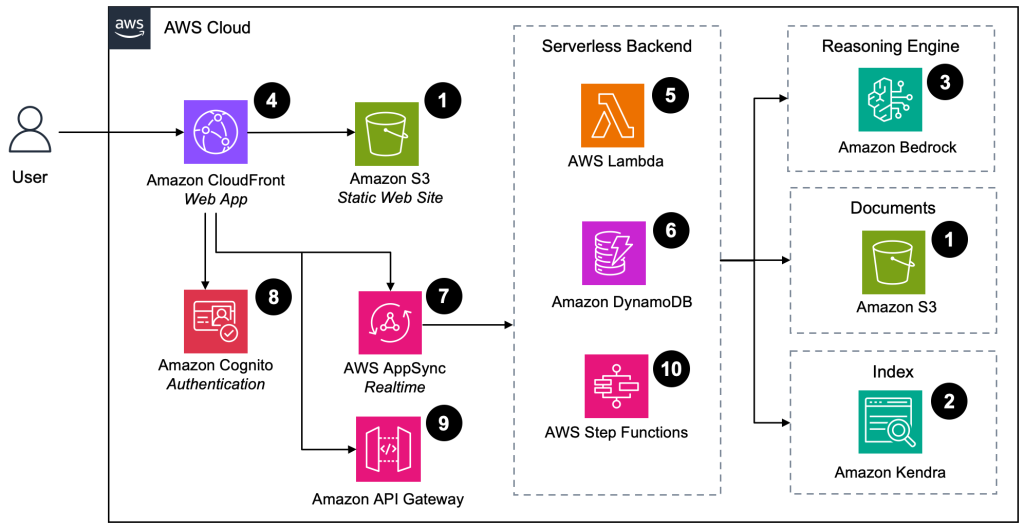

Originally appeared here:
Revolutionizing knowledge management: VW’s AI prototype journey with AWS
Go Here to Read this Fast! Revolutionizing knowledge management: VW’s AI prototype journey with AWS
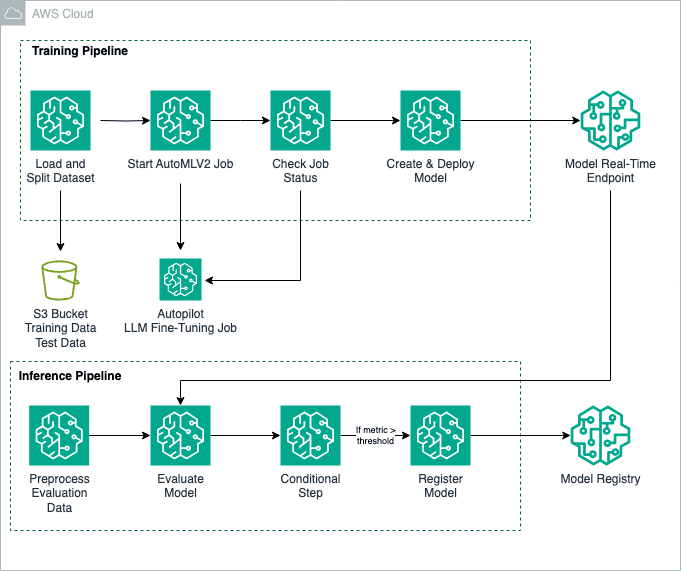

Originally appeared here:
Fine-tune large language models with Amazon SageMaker Autopilot
Go Here to Read this Fast! Fine-tune large language models with Amazon SageMaker Autopilot
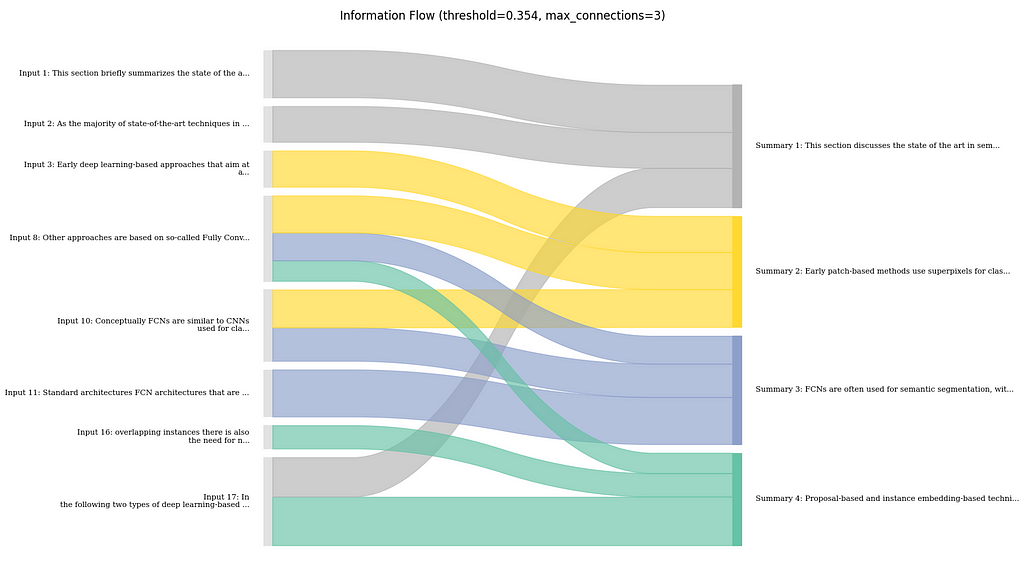


There are a lot of good reasons to get explanations for your model outputs. For example, they could help you find problems with your model, or they just could be a way to provide more transparency to the user, thereby facilitating user trust. This is why, for models like XGBoost, I have regularly applied methods like SHAP to get more insights into my model’s behavior.
Now, with myself more and more dealing with LLM-based ML systems, I wanted to explore ways of explaining LLM models the same way I did with more traditional ML approaches. However, I quickly found myself being stuck because:
After playing with quantization and even spinning up GPU cloud instances with still limited success I had enough I took a step back.
For understanding the approach, let’s first briefly define what we want to achieve. Concretely, we want to identify and highlight sections in our input text (e.g. long text document or RAG context) that are highly relevant to our model output (e.g., a summary or RAG answer).
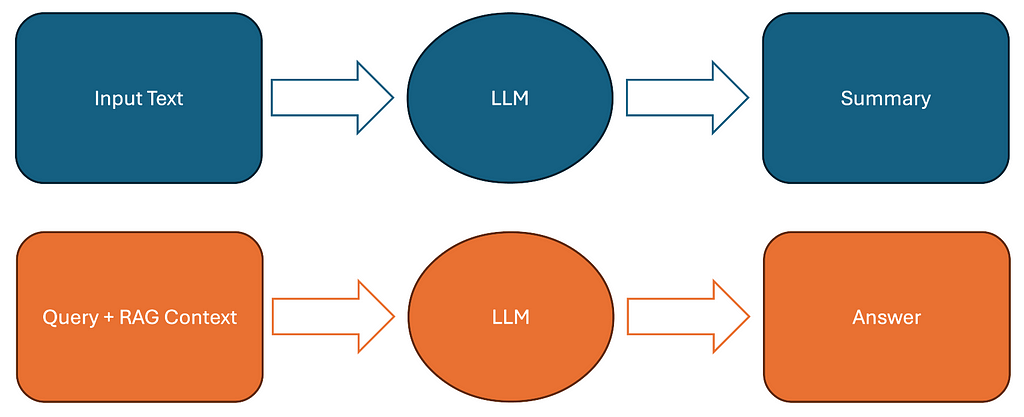
In case of summarization, our method would have to highlight parts of the original input text that are highly reflected in the summary. In case of a RAG system, our approach would have to highlight document chunks from the RAG context that are showing up in the answer.
Since directly explaining the LLM itself has proven intractable for me, I instead propose to model the relation between model inputs and outputs via a separate text similarity model. Concretely, I implemented the following simple but effective approach:
In code, this is implemented as shown below. For running the code you need the Huggingface Transformers, Sentence Transformers, and NLTK libraries.
Please, also check out this Github Repository for the full code accompanying this blog post.
from sentence_transformers import SentenceTransformer
from nltk.tokenize import sent_tokenize
import numpy as np
# Original text truncated for brevity ...
text = """This section briefly summarizes the state of the art in the area of semantic segmentation and semantic instance segmentation. As the majority of state-of-the-art techniques in this area are deep learning approaches we will focus on this area. Early deep learning-based approaches that aim at assigning semantic classes to the pixels of an image are based on patch classification. Here the image is decomposed into superpixels in a preprocessing step e.g. by applying the SLIC algorithm [1].
Other approaches are based on so-called Fully Convolutional Neural Networks (FCNs). Here not an image patch but the whole image are taken as input and the output is a two-dimensional feature map that assigns class probabilities to each pixel. Conceptually FCNs are similar to CNNs used for classification but the fully connected layers are usually replaced by transposed convolutions which have learnable parameters and can learn to upsample the extracted features to the final pixel-wise classification result. ..."""
# Define a concise summary that captures the key points
summary = "Semantic segmentation has evolved from early patch-based classification approaches using superpixels to more advanced Fully Convolutional Networks (FCNs) that process entire images and output pixel-wise classifications."
# Load the embedding model
model = SentenceTransformer('BAAI/bge-small-en')
# Split texts into sentences
input_sentences = sent_tokenize(text)
summary_sentences = sent_tokenize(summary)
# Calculate embeddings for all sentences
input_embeddings = model.encode(input_sentences)
summary_embeddings = model.encode(summary_sentences)
# Calculate similarity matrix using cosine similarity
similarity_matrix = np.zeros((len(summary_sentences), len(input_sentences)))
for i, sum_emb in enumerate(summary_embeddings):
for j, inp_emb in enumerate(input_embeddings):
similarity = np.dot(sum_emb, inp_emb) / (np.linalg.norm(sum_emb) * np.linalg.norm(inp_emb))
similarity_matrix[i, j] = similarity
# Calculate final attribution scores (mean aggregation)
final_scores = np.mean(similarity_matrix, axis=0)
# Create and print attribution dictionary
attributions = {
sentence: float(score)
for sentence, score in zip(input_sentences, final_scores)
}
print("nInput sentences and their attribution scores:")
for sentence, score in attributions.items():
print(f"nScore {score:.3f}: {sentence}")
So, as you can see, so far, that is pretty simple. Obviously, we don’t explain the model itself. However, we might be able to get a good sense of relations between input and output sentences for this specific type of tasks (summarization / RAG Q&A). But how does this actually perform and how to visualize the attribution results to make sense of the output?
To visualize the outputs of this approach, I created two visualizations that are suitable for showing the feature attributions or connections between input and output of the LLM, respectively.
These visualizations were generated for a summary of the LLM input that goes as follows:
This section discusses the state of the art in semantic segmentation and instance segmentation, focusing on deep learning approaches. Early patch classification methods use superpixels, while more recent fully convolutional networks (FCNs) predict class probabilities for each pixel. FCNs are similar to CNNs but use transposed convolutions for upsampling. Standard architectures include U-Net and VGG-based FCNs, which are optimized for computational efficiency and feature size. For instance segmentation, proposal-based and instance embedding-based techniques are reviewed, including the use of proposals for instance segmentation and the concept of instance embeddings.
For visualizing the feature attributions, my choice was to simply stick to the original representation of the input data as close as possible.
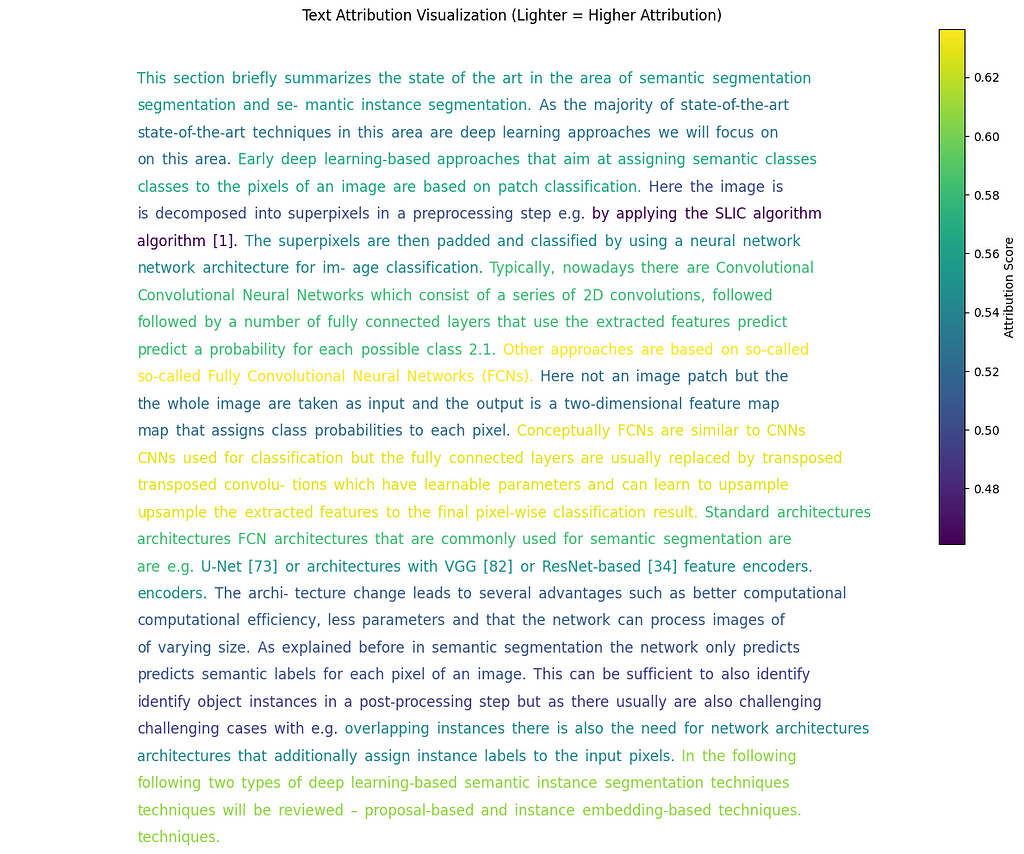
Concretely, I simply plot the sentences, including their calculated attribution scores. Therefore, I map the attribution scores to the colors of the respective sentences.
In this case, this shows us some dominant patterns in the summarization and the source sentences that the information might be stemming from. Concretely, the dominance of mentions of FCNs as an architecture variant mentioned in the text, as well as the mention of proposal- and instance embedding-based instance segmentation methods, are clearly highlighted.
In general, this method turned out to work pretty well for easily capturing attributions on the input of a summarization task, as it is very close to the original representation and adds very low clutter to the data. I could imagine also providing such a visualization to the user of a RAG system on demand. Potentially, the outputs could also be further processed to threshold to certain especially relevant chunks; then, this could also be displayed to the user by default to highlight relevant sources.
Again, check out the Github Repository to get the visualization code
Another visualization technique focuses not on the feature attributions, but mostly on the flow of information between input text and summary.
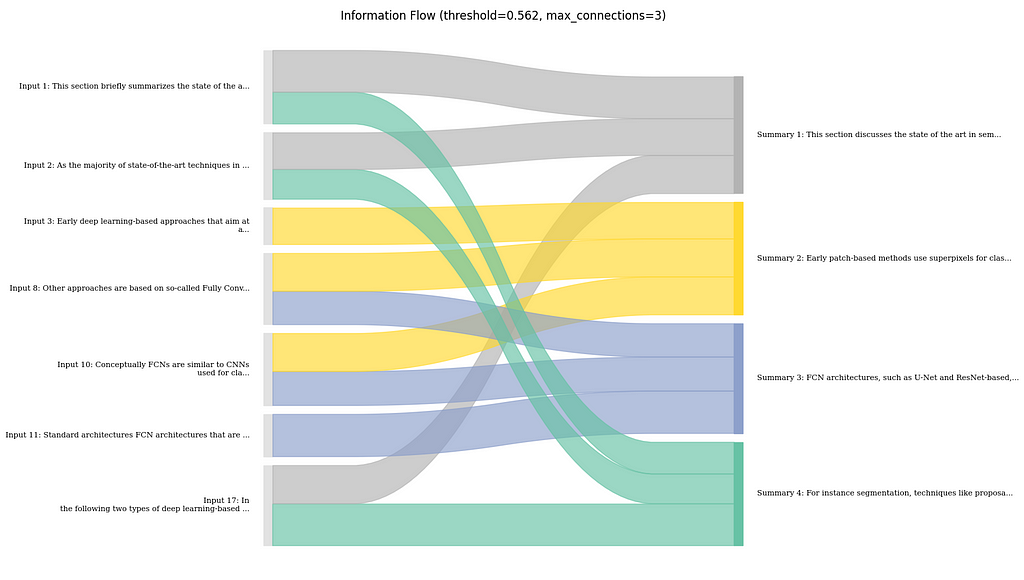
Concretely, what I do here, is to first determine the major connections between input and output sentences based on the attribution scores. I then visualize those connections using a Sankey diagram. Here, the width of the flow connections is the strength of the connection, and the coloring is done based on the sentences in the summary for better traceability.
Here, it shows that the summary mostly follows the order of the text. However, there are few parts where the LLM might have combined information from the beginning and the end of the text, e.g., the summary mentions a focus on deep learning approaches in the first sentence. This is taken from the last sentence of the input text and is clearly shown in the flow chart.
In general, I found this to be useful, especially to get a sense on how much the LLM is aggregating information together from different parts of the input, rather than just copying or rephrasing certain parts. In my opinion, this can also be useful to estimate how much potential for error there is if an output is relying too much on the LLM for making connections between different bits of information.
In the code provided on Github I implemented certain extensions of the basic approach shown in the previous sections. Concretely I explored the following:
As said, all this is demoed in the provided Code so make sure to check that out as well.
In general, I found it pretty challenging to find tutorials that truly demonstrate explainability techniques for non-toy scenarios in RAG and summarization. Especially techniques that are useful in “real-time” scenarios, and are thus providing low-latency seemed to be scarce. However, as shown in this post, simple solutions can already give quite nice results when it comes to showing relations between documents and answers in a RAG use case. I will definitely explore this further and see how I can probably use that in RAG production scenarios, as providing traceable outputs to the users has proven invaluable to me. If you are interested in the topic and want to get more content in this style, follow me here on Medium and on LinkedIn.
Explaining LLMs for RAG and Summarization was originally published in Towards Data Science on Medium, where people are continuing the conversation by highlighting and responding to this story.
Originally appeared here:
Explaining LLMs for RAG and Summarization
Go Here to Read this Fast! Explaining LLMs for RAG and Summarization
Feeling inspired to write your first TDS post? We’re always open to contributions from new authors.
Taking the first step towards mastering a new topic is always a bit daunting—sometimes it’s even very daunting! It doesn’t matter if you’re learning about algorithms for the first time, dipping your toes into the exciting world of LLMs, or have just been tasked with revamping your team’s data stack: taking on a challenge with little or no prior experience requires nontrivial amounts of courage and grit.
The calm and nuanced perspective of more seasoned practitioners can go a long way, too — which is where our authors excel. This week, we’ve gathered some of our standout recent contributions that are tailored specifically to the needs of early-stage learners attempting to expand their skill set. Let’s roll up our sleeves and get started!

Ready to venture out into other topics and challenges this week? We hope so—we’ve published some excellent articles recently on LLM apps, Python-generated art, AI ethics, and more:
Thank you for supporting the work of our authors! As we mentioned above, we love publishing articles from new authors, so if you’ve recently written an interesting project walkthrough, tutorial, or theoretical reflection on any of our core topics, don’t hesitate to share it with us.
Until the next Variable,
TDS Team
Getting Started with Multimodal AI, One-Hot Encoding, and Other Beginner-Friendly Guides was originally published in Towards Data Science on Medium, where people are continuing the conversation by highlighting and responding to this story.
Originally appeared here:
Getting Started with Multimodal AI, One-Hot Encoding, and Other Beginner-Friendly Guides
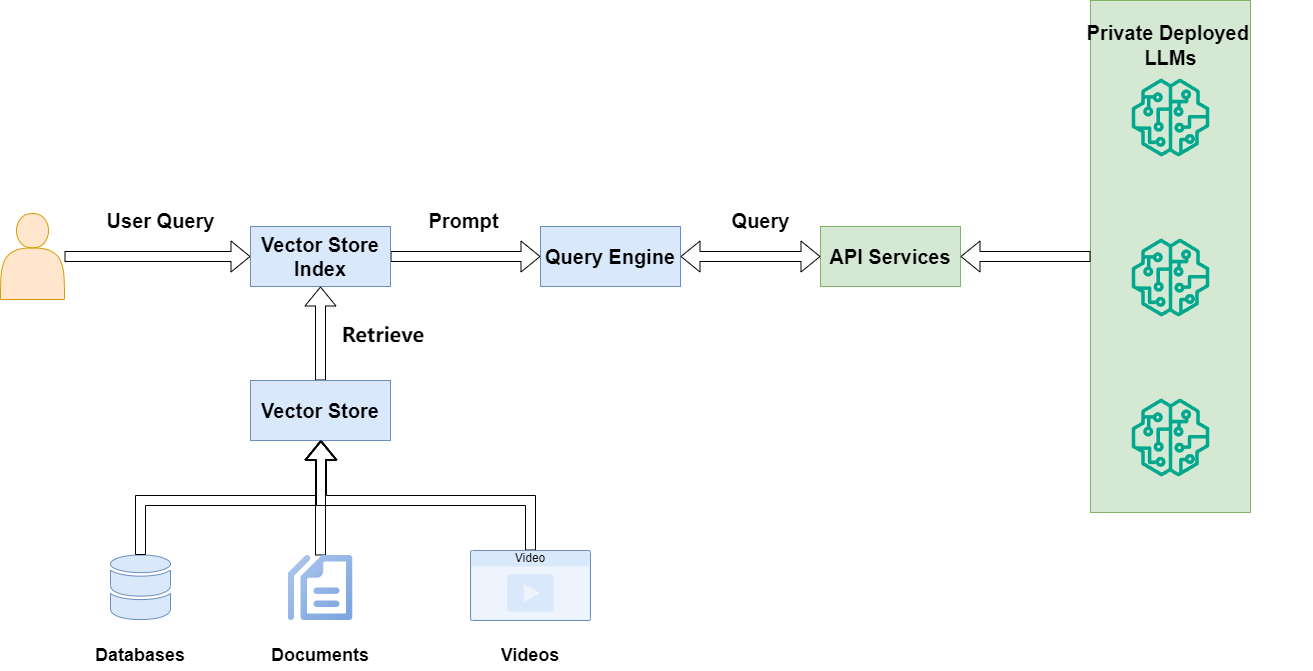
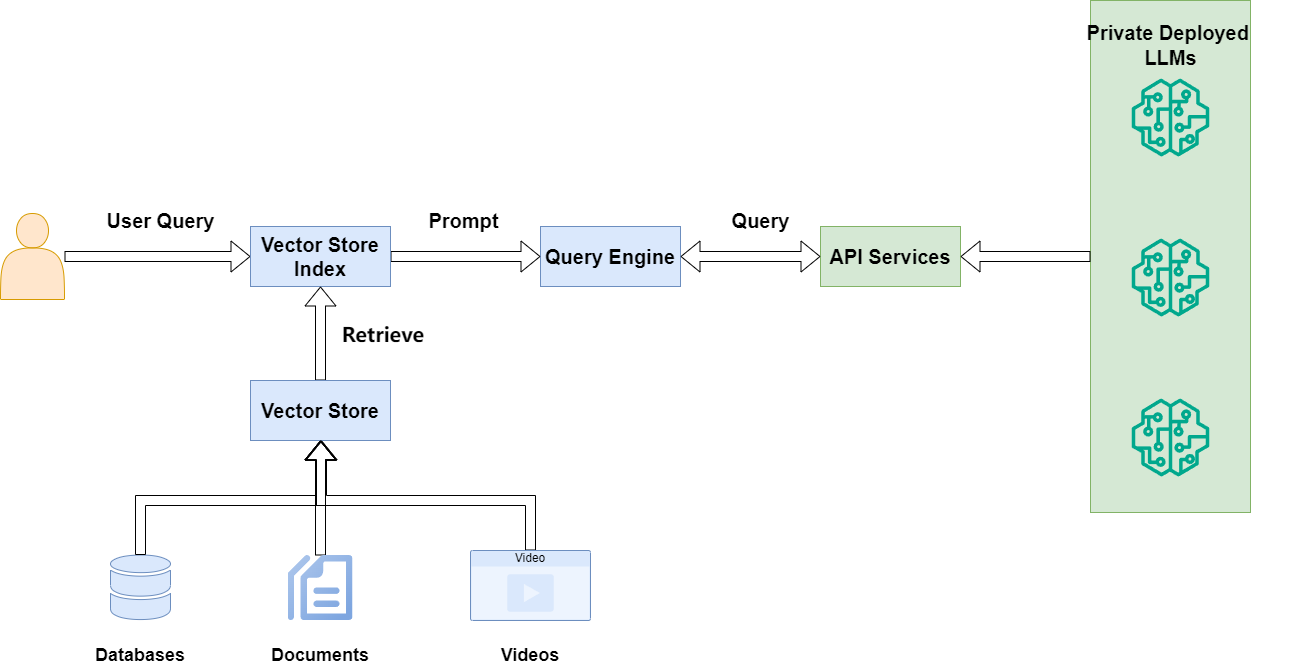
When your enterprise doesn’t use public models like OpenAI
Originally appeared here:
How to Connect LlamaIndex with Private LLM API Deployments
Go Here to Read this Fast! How to Connect LlamaIndex with Private LLM API Deployments
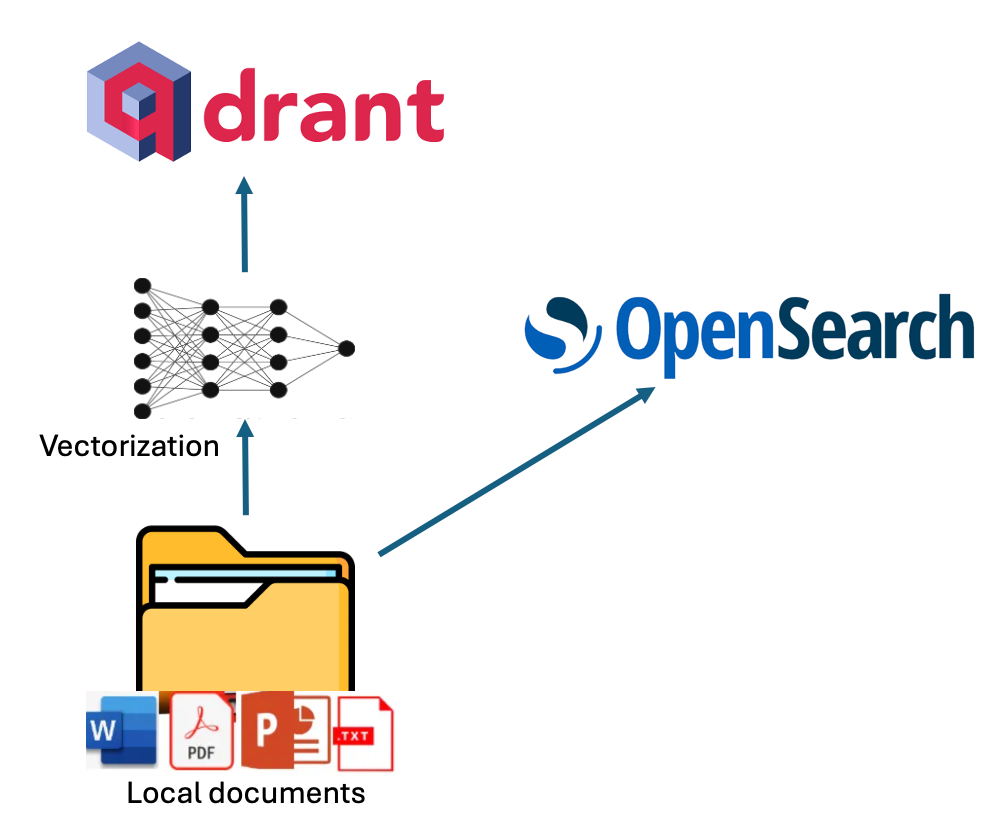
Nikola Milosevic (Data Warrior)
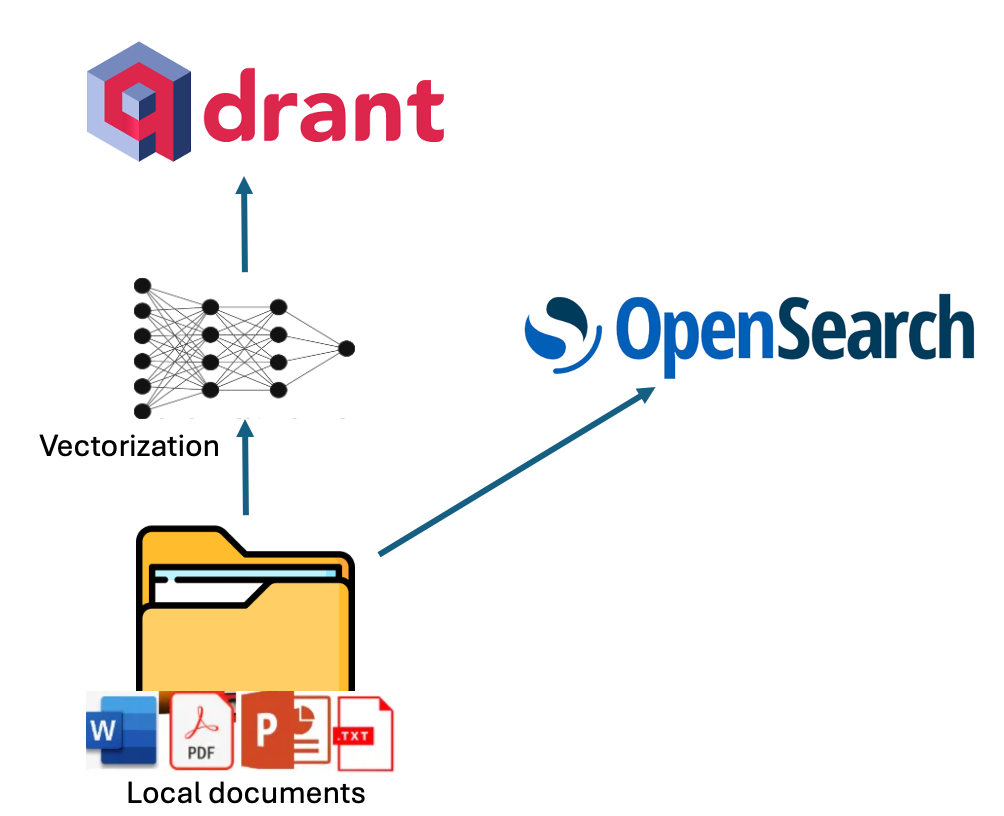
I have previously written about building your own simple generative search, as well as on the VerifAI project on Towards Data Science. However, there has been a major update worth revisiting. Initially, VerifAI was developed as a biomedical generative search with referenced and AI-verified answers. This version is still available, and we now call it VerifAI BioMed. It can be accessed here: https://app.verifai-project.com/.
The major update, however, is that you can now index your local files and turn them into your own generative search engine (or productivity engine, as some refer to these systems based on GenAI). It can serve also as an enterprise or organizational generative search. We call this version VerifAI Core, as it serves as the foundation for the other version. In this article, we will explore how you can in a few simple steps, deploy it and start using it. Given that it has been written in Python, it can be run on any kind of operating system.
The best way to describe a generative search engine is by breaking it down into three parts (or components, in our case):
Indexing in VerifAI can be done by pointing its indexer script to a local folder containing files such as PDF, MS Word, PowerPoint, Text, or Markdown (.md). The script reads and indexes these files. Indexing is performed in dual mode, utilizing both lexical and semantic indexing.
For lexical indexing, VerifAI uses OpenSearch. For semantic indexing, it vectorizes chunks of the documents using an embedding model specified in the configuration file (models from Hugging Face are supported) and then stores these vectors in Qdrant. A visual representation of this process is shown in the diagram below.

When it comes to answering questions using VerifAI, the method is somewhat complex. User questions, written in natural language, undergo preprocessing (e.g., stopwords are excluded) and are then transformed into queries.
For OpenSearch, only lexical processing is performed (e.g., excluding stopwords), and the most relevant documents are retrieved. For Qdrant, the query is transformed into embeddings using the same model that was used to embed document chunks when they were stored in Qdrant. These embeddings are then used to query Qdrant, retrieving the most similar documents based on dot product similarity. The dot product is employed because it accounts for both the angle and magnitude of the vectors.
Finally, the results from the two engines must be merged. This is done by normalizing the retrieval scores from each engine to values between 0 and 1 (achieved by dividing each score by the highest score from its respective engine). Scores corresponding to the same document are then added together and sorted by their combined score in descending order.
Using the retrieved documents, a prompt is built. The prompt contains instructions, the top documents, and the user’s question. This prompt is then passed to the large language model of choice (which can be specified in the configuration file, or, if no model is set, defaults to our locally deployed fine-tuned version of Mistral). Finally, a verification model is applied to ensure there are no hallucinations, and the answer is presented to the user through the GUI. The schematic of this process is shown in the image below.

To install VerifAI Generative Search, you can start by cloning the latest codebase from GitHub or using one of the available releases.
git clone https://github.com/nikolamilosevic86/verifAI.git
When installing VerifAI Search, it is recommended to start by creating a clean Python environment. I have tested it with Python 3.6, but it should work with most Python 3 versions. However, Python 3.10+ may encounter compatibility issues with certain dependencies.
To create a Python environment, you can use the venv library as follows:
python -m venv verifai
source verifai/bin/activate
After activating the environment, you can install the required libraries. The requirements file is located in the verifAI/backend directory. You can run the following command to install all the dependencies:
pip install -r requirements.txt
The next step is configuring VerifAI and its interactions with other tools. This can be done either by setting environment variables directly or by using an environment file (the preferred option).
An example of an environment file for VerifAI is provided in the backend folder as .env.local.example. You can rename this file to .env, and the VerifAI backend will automatically read it. The file structure is as follows:
SECRET_KEY=6293db7b3f4f67439ad61d1b798242b035ee36c4113bf870
ALGORITHM=HS256
DBNAME=verifai_database
USER_DB=myuser
PASSWORD_DB=mypassword
HOST_DB=localhost
OPENSEARCH_IP=localhost
OPENSEARCH_USER=admin
OPENSEARCH_PASSWORD=admin
OPENSEARCH_PORT=9200
OPENSEARCH_USE_SSL=False
QDRANT_IP=localhost
QDRANT_PORT=6333
QDRANT_API=8da7625d78141e19a9bf3d878f4cb333fedb56eed9097904b46ce4c33e1ce085
QDRANT_USE_SSL=False
OPENAI_PATH=<model-deployment-path>
OPENAI_KEY=<model-deployment-key>
OPENAI_DEPLOYMENT_NAME=<name-of-model-deployment>
MAX_CONTEXT_LENGTH=128000
USE_VERIFICATION = True
EMBEDDING_MODEL="sentence-transformers/msmarco-bert-base-dot-v5"
INDEX_NAME_LEXICAL = 'myindex-lexical'
INDEX_NAME_SEMANTIC = "myindex-semantic"
Some of the variables are quite straightforward. The first Secret key and Algorithm are used for communication between the frontend and the backend.
Then there are variables configuring access to the PostgreSQL database. It needs the database name (DBNAME), username, password, and host address where the database is located. In our case, it is on localhost, on the docker image.
The next section is the configuration of OpenSearch access. There is IP (localhost in our case again), username, password, port number (default port is 9200), and variable defining whether to use SSL.
A similar configuration section has Qdrant, just for Qdrant, we use an API key, which has to be here defined.
The next section defined the generative model. VerifAI uses the OpenAI python library, which became the industry standard, and allows it to use both OpenAI API, Azure API, and user deployments via vLLM, OLlama, or Nvidia NIMs. The user needs to define the path to the interface, API key, and model deployment name that will be used. We are soon adding support where users can modify or change the prompt that is used for generation. In case no path to an interface is provided and no key, the model will download the Mistral 7B model, with the QLoRA adapter that we have fine-tuned, and deploy it locally. However, in case you do not have enough GPU RAM, or RAM in general, this may fail, or work terribly slowly.
You can set also MAX_CONTEXT_LENGTH, in this case it is set to 128,000 tokens, as that is context size of GPT4o. The context length variable is used to build context. Generally, it is built by putting in instruction about answering question factually, with references, and then providing retrieved relevant documents and question. However, documents can be large, and exceed context length. If this happens, the documents are splitted in chunks and top n chunks that fit into the context size will be used to context.
The next part contains the HuggingFace name of the model that is used for embeddings of documents in Qdrant. Finally, there are names of indexes both in OpenSearch (INDEX_NAME_LEXICAL) and Qdrant (INDEX_NAME_SEMANTIC).
As we previously said, VerifAI has a component that verifies whether the generated claim is based on the provided and referenced document. However, this can be turned on or off, as for some use-cases this functionality is not needed. One can turn this off by setting USE_VERIFICATION to False.
The final step of the installation is to run the install_datastores.py file. Before running this file, you need to install Docker and ensure that the Docker daemon is running. As this file reads configuration for setting up the user names, passwords, or API keys for the tools it is installing, it is necessary to first make a configuration file. This is explained in the next section.
This script sets up the necessary components, including OpenSearch, Qdrant, and PostgreSQL, and creates a database in PostgreSQL.
python install_datastores.py
Note that this script installs Qdrant and OpenSearch without SSL certificates, and the following instructions assume SSL is not required. If you need SSL for a production environment, you will need to configure it manually.
Also, note that we are talking about local installation on docker here. If you already have Qdrant and OpenSearch deployed, you can simply update the configuration file to point to those instances.
This configuration is used by both the indexing method and the backend service. Therefore, it must be completed before indexing. Once the configuration is set up, you can run the indexing process by pointing index_files.py to the folder containing the files to be indexed:
python index_files.py <path-to-directory-with-files>
We have included a folder called test_data in the repository, which contains several test files (primarily my papers and other past writings). You can replace these files with your own and run the following:
python index_files.py test_data
This would run indexing over all files in that folder and its subfolders. Once finished, one can run VerifAI services for backend and frontend.
The backend of VerifAI can be run simply by running:
python main.py
This will start the FastAPI service that would act as a backend, and pass requests to OpenSearch, and Qdrant to retrieve relevant files for given queries and to the deployment of LLM for generating answers, as well as utilize the local model for claim verification.
Frontend is a folder called client-gui/verifai-ui and is written in React.js, and therefore would need a local installation of Node.js, and npm. Then you can simply install dependencies by running npm install and run the front end by running npm start:
cd ..
cd client-gui/verifai-ui
npm install
npm start
Finally, things should look somehow like this:
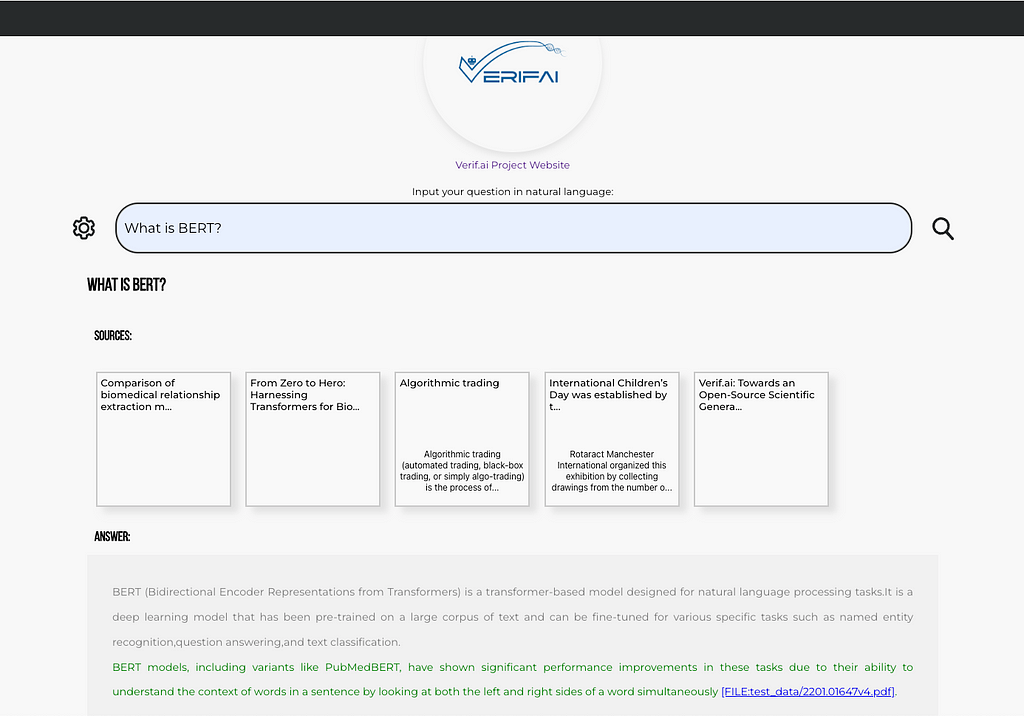
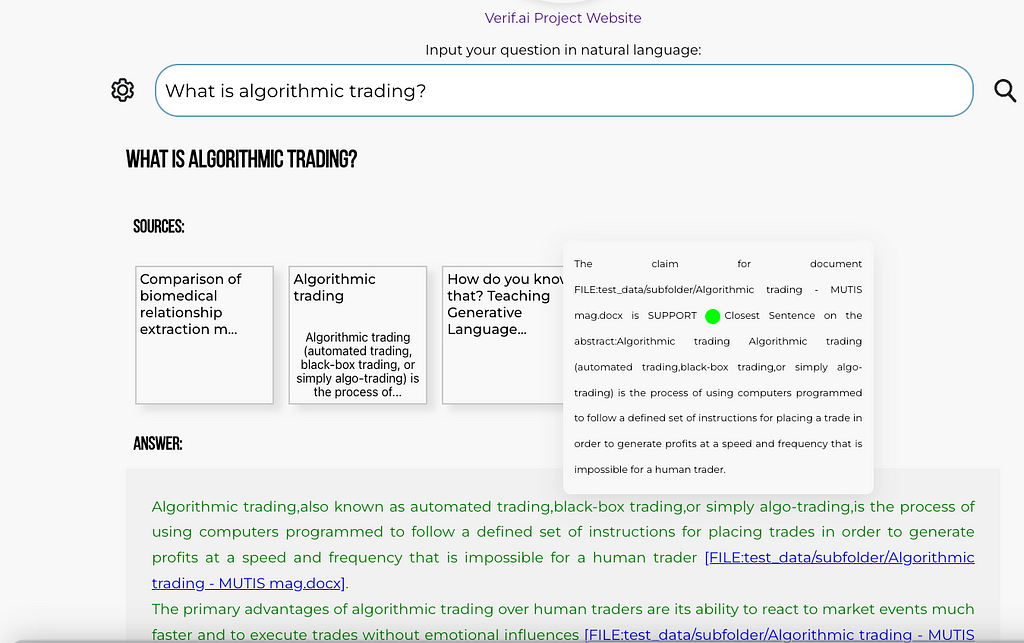
So far, VerifAI has been started with the help of funding from the Next Generation Internet Search project as a subgrant of the European Union. It was started as a collaboration between The Institute for Artificial Intelligence Research and Development of Serbia and Bayer A.G.. The first version has been developed as a generative search engine for biomedicine. This product will continue to run at https://app.verifai-project.com/. However, lately, we decided to expand the project, so it can truly become an open-source generative search with verifiable answers for any files, that can be leveraged openly by different enterprises, small and medium companies, non-governmental organizations, or governments. These modifications have been developed by Natasa Radmilovic and me voluntarily (huge shout out to Natasa!).
However, given this is an open-source project, available on GitHub (https://github.com/nikolamilosevic86/verifAI), we are welcoming contributions by anyone, via pull requests, bug reports, feature requests, discussions, or anything else you can contribute with (feel free to get in touch — for both BioMed and Core (document generative search, as described here) versions website will remain the same — https://verifai-project.com). So we welcome you to contribute, start our project, and follow us in the future.
How to Easily Deploy a Local Generative Search Engine Using VerifAI was originally published in Towards Data Science on Medium, where people are continuing the conversation by highlighting and responding to this story.
Originally appeared here:
How to Easily Deploy a Local Generative Search Engine Using VerifAI
Go Here to Read this Fast! How to Easily Deploy a Local Generative Search Engine Using VerifAI


It is worth mentioning that this article comes from an Electrical and Electronic Engineer graduate who went all the way and spent almost 8 years in academia learning about the Energy sector (and when I say all the way, I mean from a bachelor degree to a PhD and postdoc). Even though that’s also a high demand career in the job market, I decided to switch to a data engineer path instead.
I constantly come across posts in forums and blogs where people from different disciplines ask about how to switch to a career in data. So this article will take you through my journey, and how an engineering graduate has nothing to worry about the transition to this new field. I’ll go through the market for data jobs, my story, and the skills that engineers have (whether it’s electrical, mechanical, electronic etc.) that equip them well for this fast moving field.

As technology continues to advance exponentially (IoT devices, AI, web services etc.) so does the amount of data generated every day. The result from this? The need for AI and Data professionals is currently at an all time high and I think it is only going to get higher. It’s currently at a level that the demand for these professionals severely outgrows supply and new job listings are popping out every day.
According to Dice Tech Job Report, positions like Data Engineers and Data Scientists are amongst the fastest growing tech occupations. The reason being that companies have finally come to the realization that, with data, you can unlock unlimited business insights which can reveal their product’s strengths and weaknesses. That is, if analyzed the correct way.
So what does this mean for the future data professionals looking for a job? The following should be true, at least for the next few years:
So here comes the million dollar question: How can an Engineer, whether that is mechanical, electronic, electrical, civil etc. switch to a career in data? Great question.
Is it easy? No. Is it worth it? Definitely. There’s no correct answer for this question. However, I can tell you my experiences and you can judge on your own. I can also tell you the similarities I found between my engineering degree and what I’m doing now. So let’s start.
The year is 2020 and I’m about to finish my PhD. Confused about my options and what I can do after a long 4-year PhD (and with a severe imposter syndrome too), I chose the safe path of academia and a postdoc position at a Research and Development center.

Whilst working there, I realized that I need to get out of academia. I no longer had the strength to read more papers, proposals or, even more so, write journal and conference papers to showcase my work. I did all those — I had enough. I had like 7–8 journal/conference papers that got published from my PhD and I didn’t really like the fact that this is the only way to showcase my work. So, I started looking for a job in the industry.
In 2021, I managed to get a job in energy consulting. And guess what? More reports, more papers and even better, PowerPoint slides! I felt like my engineering days were behind me and that I could literally do nothing useful. After a short stint at that position, I started looking for jobs again. Something with technical challenges and meaning that got my brain working. This is when I started looking for data professions where I could use the skills that I acquired throughout my career. Also, this was the time that I got the most rejections in my life!
Coming from very successful bachelor and PhD degrees, I couldn’t understand why my skills were not suited for a data position. I was applying to data engineer, analyst and scientist positions but all I received was an automated reply like “Unfortunately we can’t move forward with your application”
That’s when I started applying to literally everywhere. So if you are reading this because you can’t make the switch, believe me. I get you.
So, I started applying everywhere to anything that even relates to data. Even to positions that I didn’t have any of the job description skills. That’s where the magic happened.
I got an interview from a company in the retail sector for the position of “Commercial Intelligence Executive”. Do you know what this position is about? No? That’s right, I didn’t either. All I saw in the job description was that it required 3–5 years of experience in Data Science. So I thought, this has something to do with data, so why not. I got the job and started working there. Turns out that “Commercial Intelligence” was a job description that was basically business intelligence for the commercial department. Lucky me, it was spot on. It gave me the opportunity to start experimenting with business intelligence.

In that position, I used Power BI at first, since the role was about building reports and dashboards. Then, I was hungry for more. I was fortunate that my manager was amazing so he/she trusted me to do whatever I wanted with data. And so I did.
Before I knew it, my engineering skills were back. All the problem solving skills that I got throughout the years, the bug for solving challenges and the exposure to different programming languages started connecting with each other. I started building automations in Power BI, then extended this to writing SQL to automate more things and then building data pipelines using Python. In 1 year’s time, I had all my processes pretty much automated and I knew that I had the technical capability to take on more challenging and technically intensive problems. I built incredible dashboards that brought useful insights to the business owners and that felt incredible.
This was the lightbulb moment. That this career, no matter what the data is about, was what I was looking for.
After one and a half years at the company, I knew it was time to go for something more technically challenging than just business intelligence. That’s when an opportunity turned out for me for a data engineer position and I took it.

For the past one and a half years I’ve been working in the finance sector as a data engineer. I expanded my knowledge to more things such as AI, real-time streaming data pipelines, APIs, automations and so much more. Job opportunities are coming up all the time and I feel fortunate that I have made this switch, and I couldn’t recommend it enough. Was it challenging? I’ll say that the only challenging part in both BI and data engineering positions was the first 3 months until I got to know the tools we use and the environments. My engineering expertise equipped me well to deal with different problems with excitement and do amazing things. I wouldn’t change my degree for anything else. Not even for a Computer Science degree. How did my engineering degree help throughout this transition? This is discussed in the next section.
So if you’ve read this far, you must be wondering: How is my engineering degree preparing me for a career in data? This guy has told me nothing about this. You are right, let’s get into it.
Engineering degrees are important, not because of the discipline but the way that they structure the brains of those they study it. This is my personal opinion, but going through my engineering degrees they have exposed me to so many things and have prepared me to solve problems in every single bit that I feel much more confident now. But let’s get to the specifics. These are some key engineering skills that I see similarities and I get to use at my data role every single day:
All the above help me every single day in my data engineer position. Can you see the transferrable skills now?
Whilst I don’t want to encourage all the engineering disciplines to jump into a data position, I still think that all engineers are useful, I wanted to write this article to encourage the people that want to do the switch. There’s so much rejection nowadays but at the same time opportunities. All you need is the right opportunity and then magic will follow since you will be able to exploit your skills. The important thing is to keep trying.
If you liked this article, please give me a few claps and follow me on https://medium.com/@loizosloizou08
There’s more content to follow 🙂
Rewiring My Career: How I Transitioned from Electrical Engineering to Data Engineering was originally published in Towards Data Science on Medium, where people are continuing the conversation by highlighting and responding to this story.
Originally appeared here:
Rewiring My Career: How I Transitioned from Electrical Engineering to Data Engineering


Hasn’t everyone started using ReFT yet?
Stanford published the paper ReFT: Representation finetuning for language models in May 2024, which immediately showed its great potential. In July 2024, Oxen.ai presented an experiment finetuning Llama3 (8B) on a single Nvidia A10 GPU within 14 mins, further demonstrating this technique’s power.
Unlike SOTA PEFT methods, which focus on modifying the model weights or input, the ReFT technique is based on a previously proposed distributed interchange intervention (DII) method. The DII method first projects the embedding from the deep learning model to a lower dimension subspace and then interferes through the subspace for fine-tuning purposes.
In the following, we’ll first walk the readers through SOTA fine-tuning PEFT algorithms such as LoRA, prompt tuning, and prefix tuning; then we’ll discuss the original DII method to provide a better context for understanding; lastly, we’ll discuss the ReFT technique and present the results from the paper.

Hugging Face has a blog detailing different PEFT techniques for fine-tuning LLMs. Here, we quickly recap these techniques.
Proposed in 2021, LoRA has become one of the most successful techniques for fine-tuning LLMs and diffusion models (e.g., Time-varying LoRA) due to its simplicity and generalization ability. The idea is simple: instead of fine-tuning the original weight parameters for each layer, the LoRA technique adds two low-rank matrices and only finetunes the low-rank matrices. The trainable parameters could be reduced to less than 0.3% during fine-tuning of the whole network, which significantly speeds up the learning process and minimizes the GPU memory.
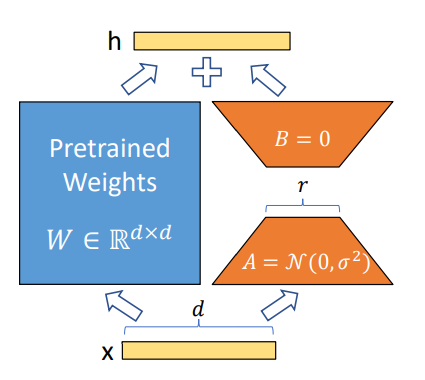
Instead of changing the pre-trained model’s inner layers, the Prompt Tuning technique proposed to use “soft prompts,” a learnable task-specific prompt embedding as a prefix. Given mixed-task batch prompts, the model could efficiently perform multi-task prediction without extra task-specific model copy (as against the Model Tuning in the following left sub-figure).
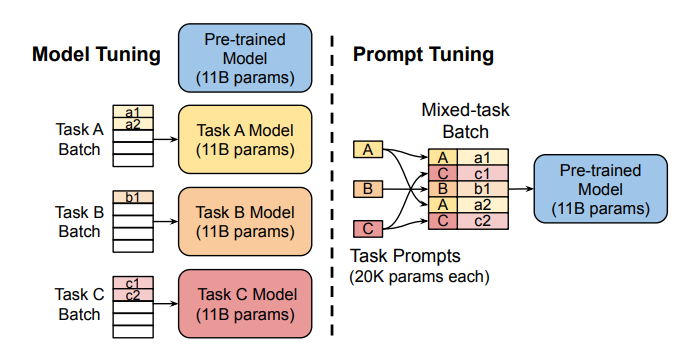
To provide universality for prompt tuning models at scales (e.g., over 10B parameters), Prefix Tuning (P-Tuning v2) proposed to prefix trainable prompt embeddings at different layers, which allows learning task-specific information at various scales.

Among all these PEFT techniques, LoRA is the most widely used in fine-tuning LLMs for its robustness and efficiency. A detailed empirical analysis can be found in this paper.
Causal abstraction is a robust artificial intelligence framework that uses the intervention between a causal model (a high-level model) and a neural network model (or a low-level model) to induce alignment estimation. If there exists an alignment between the two models, we know the underlying mechanisms between the causal model and the NN are the same. The approach of discovering the underlying alignment by intervention is called interchange intervention (II), which is intuitively explained in this lecture video.
However, classical causal abstraction uses brute force to search through all possible alignments of model states, which is less optimal. A Distributed Interchange Intervention (DII) system first projects high-level and low-level models to sub-spaces through a series of orthogonal projections and then produces an intervened model using certain rotation operations. A fascinating intervention experiment on vision models can be found here.
More specifically, the DII could be written as the following:

Where R is a low-rank matrix with orthogonal rows, indicating orthogonal projections; b and s are two different representations encoded by the model from two different inputs; the intervention will happen on the low-rank space, e.g., the space that contains Rs and Rb; the projection matrix R will be further learnt by distributed alignment search (DAS), which optimizes towards “the subspace that would maximize the probability of expected counterfactual output after intervention.”
Thus, the ReFT technique could be seen as the intervention of the model’s hidden representation in a lower dimension space, as illustrated below, where phi is the intervention and directly applied to the hidden representation at layer L and position P:
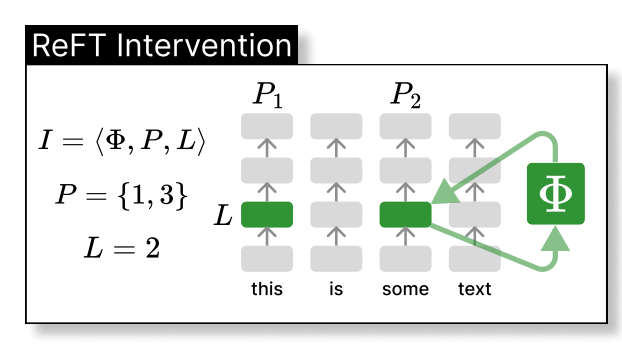
Specifically, the paper further proposes a Low-rank Linear Subspace Reft (LoReFT), which further introduces a learnt projected source:

Where h is the hidden representation, (Rs = Wh + b) is the learnt protected source, which edits the representation h in the projected low-dimension space spanned by R. Now, we can illustrate the LoReFT in the original deep neural network layer below.

When fine-tuning on an LLM, the parameters of the LM are kept frozen while only the parameters of the projection phi={R, W, b} are trained.
The original paper shows experiments comparing the LoReFT (and other techniques from the ReFT family) to full fine-tuning (FT), LoRA, Prefix-tuning, etc., on four types of benchmarks: common-sense reasoning, arithmetic reasoning, instruction following, and natural language understanding. We can see that, compared to LoRA, the ReFT techniques further reduce the parameters by at least 90% while achieving higher performance by a large margin.
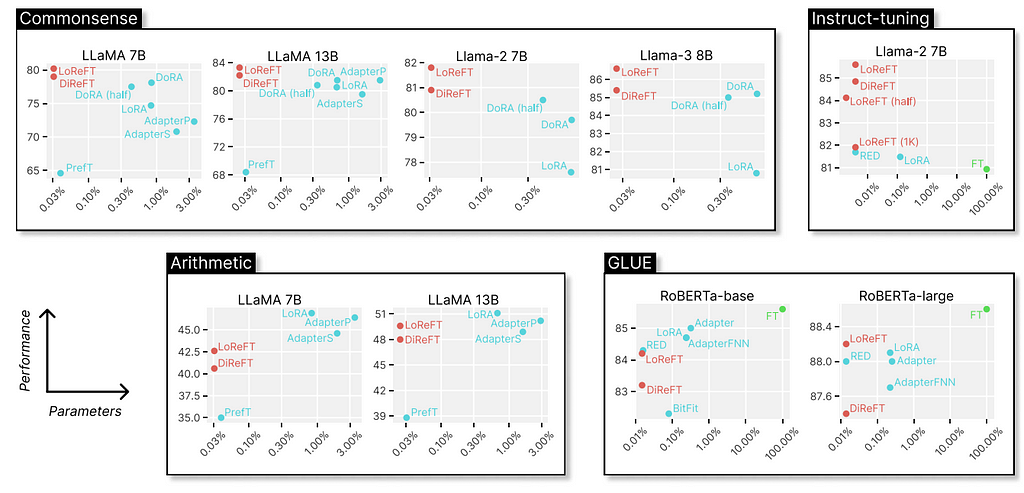
Why is ReFT so fascinating? Firstly, the technique provides convincing results with Llama-family models on various benchmarks outperforming the SOTA fine-tuning methods. Secondly, the technique is deeply rooted in the causal abstraction algorithm, which offers further ground for model interpretation, especially from the hidden representation’s perspective. As mentioned in the original paper, ReFT shows that “a linear subspace distributed across a set of neurons can achieve generalized control over a vast number of tasks,” which might further open doors for helping us better understand large language models.
Is ReFT All We Needed? was originally published in Towards Data Science on Medium, where people are continuing the conversation by highlighting and responding to this story.
Originally appeared here:
Is ReFT All We Needed?



Imagine if your customer data could tell a story — one that drove key decisions, optimized pricing, and forecast future revenue with accuracy.
As a data scientist, I have spent a large part of my career designing and building customer base management (CBM) systems. These are systems that monitor and predict anything from customer churn and customer price elasticity to recommending the products customers are most likely to buy.
I have witnessed how CBM systems have been successfully adopted by organizations, and enabled them to execute their strategy through effective pricing, improved retention and more targeted sales activities. Combining forecasting with the visual effect of dashboards, CBM systems can provide an effective way for managers to communicate with executive leadership. This enhances decision-making and helps leaders better understand the consequences of their actions, particularly regarding the customer base and projected future revenues from that base.
In this article we will explore both the foundational components of a CBM system, as well as the more advanced features that really ramp up the value generation. By the end of this guide, you’ll have a clear understanding of the key components of a CBM system and how advanced modules can enhance these foundations to give your company a competitive edge.
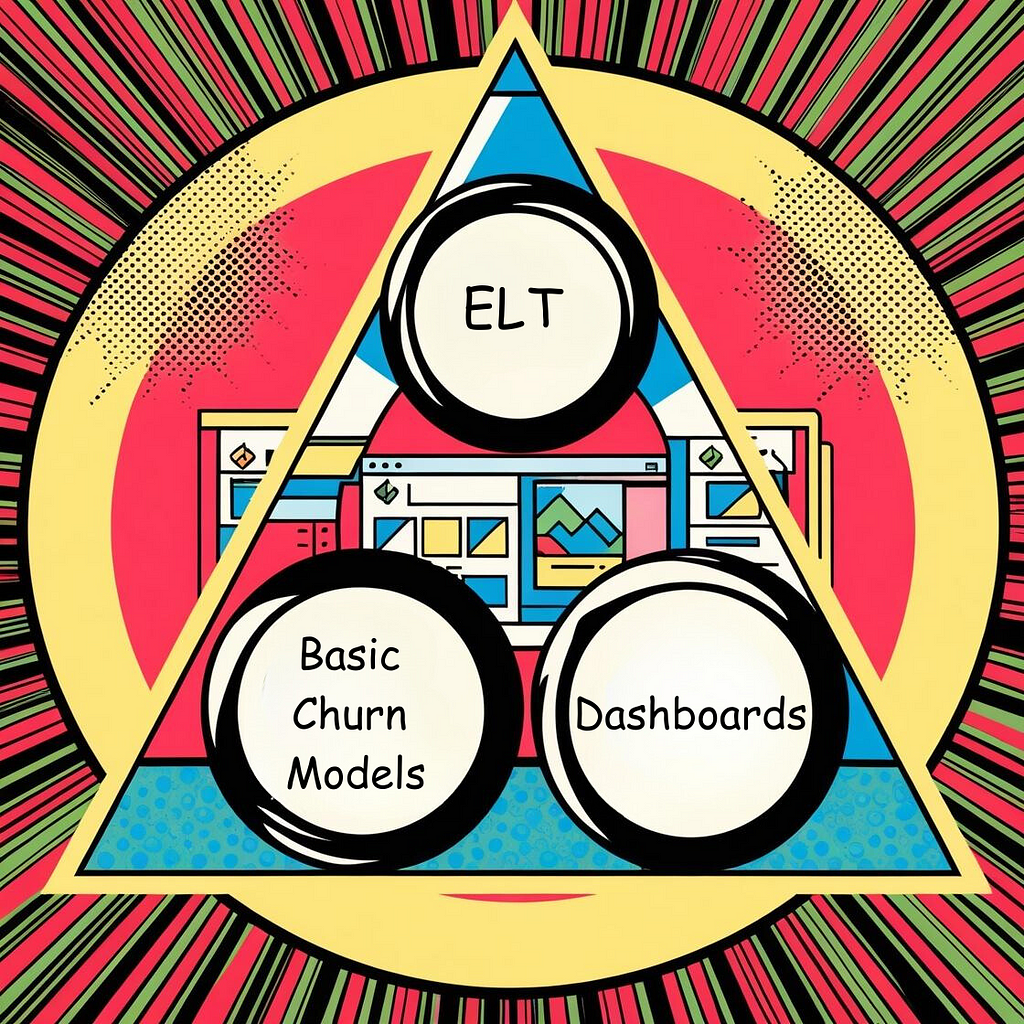
The three main foundational components of a CBM systems are:
With these three elements in place, managers are afforded a basic understanding of churn, a visual understanding of the data, and furthermore it allows them to communicate any findings to the leadership and other stakeholders. Below we detail each of these components in depth.
Extract-Load-Transform, ELT for short, is the first and most critical part of a customer base management system. This is the component that feeds the system with data, and is often the first component to be built when creating a CBM system. To get started, you will typically interact with some kind of data platform where most of the rudimentary data manipulation has already been performed (in this case you are technically only required to do the “load” and “transform”), but sometimes you need get directly from source systems as well and “extract” the data.
Irrespective of where the data comes from, it needs to be loaded into your system and transformed into a format that is easy to input into the machine learning models you are using. You will also likely need to transform the data into formats that makes it easier to make dashboards from the data. For some dashboards it might also be necessary to pre-aggregate a lot of data in smaller tables to improve query and plotting performance.
It is easy to see that if there are mistakes in the ELT process, or if there are errors in the incoming data, this has the potential to severely affect the CBM system. Since everything in the system is based on this incoming data, extra care needs to be taken to ensure accuracy and alignment with business rules.
I have seen multiple times where the ELT process has failed and led to mistakes in the churn predictions and dashboard. One way to monitor the consistency of the data coming into the system is to keep records of the distribution of each variable and track that distribution over time. In case of radical changes to the distribution you can then quickly check whether something is going wrong with the logic in the ELT process or if the problem is arising from data issues further upstream.
The second critical component in understanding your customer base is identifying who, when and why customers churn (for non-practitioners, “churn” refers to the point at which a customer stops using a product or service). A good churn prediction algorithm allows businesses to focus retention efforts where they matter most, and can help identify customers that are at an elevated risk of leaving.
Back in the mid-1990s, telcos, banks, insurance companies and utilities where some of the first to start using churn modelling on their customer base, and developing basic churn models is relatively straightforward.
The first task at hand is to decide the definition of churn. In many cases this is very straightforward, for example when a customer cancels a telco contract. However, in other industries, such as e-commerce, one needs to use some judgement when deciding on the definition of churn. For example, one could define a customer as having churned if that customer had not had a repeat shop 200 days after their last shop.
After churn has been defined, we need to select and outcome period for the model, that is a time frame within which we want to observe churn. For example, if we want to create a churn model with outcome period of 10 weeks, that would gives a a model that would predict the likelihood that a customer would churn at any point between the time of scoring and the next 10 weeks. Alternatively, we could have an outcome period of a year, which would give us a model that predicted churn at any time within the next year.
After the outcome period and churn definition has been decided, analysts need to transform the data into a format which makes it easy for the machine learning models to train on and also later for inference.
After the models are trained and predictions are being run on the active customer base, there are multiple different use cases. We can for example use the churn scores to identify customers at high risk of leaving and target them with specific retention campaigns or pricing promotions. We can also create differentiated marketing material to different groups of customers based on their churn score. Or we can use the churn score together with the products the customer has to develop customer lifetime value models, which in turn can be used to prioritize various customer activities. It is clear that proper churn models can give a company a strategic advantage in how it manages it customer base compared to competitors who neglect this basic component of CBM.
Dashboards, BI, and analytics used to be all the rage back in the 2000s and early 2010s, before the maturity of machine learning algorithms shifted our focus toward prediction over descriptive and often backwards looking data. However, for a CBM tool, dashboards remain a critical component. They allow managers to communicate effectively with leadership, especially when used alongside advanced features like price optimization. Visualizing the potential impact of a specific pricing strategy, can be very powerful for decision-making.
As with any data science project, you may invest thousands of hours in building a system, but often, the dashboard is the main point of interaction for managers and executives. If the dashboard isn’t intuitive or doesn’t perform well, it can overshadow the value of everything else you’ve built.
Additionally, dashboards offer a way to perform visual sanity checks on data and can sometimes reveal untapped opportunities. Especially in the early phases after a system has been implemented, and perhaps before all control routines have been set into production, maintaining a visual check on all variables and model performance can act as a good safety net.
With the main foundational pieces in place we can explore the more advanced features that have the potential to deliver greater value and insights.

Although a basic CBM system will offer some solid benefits and insights, to get the maximum value out of a CBM system, more advanced components are needed. Below we discuss a few of the most important components, such as having churn models with multiple time horizons, adding price optimization, using simulation-based forecasting and adding competitor pricing data.
Sometimes it makes sense to look at churn from different perspectives, and one of those angles is the time horizon — or outcome period — you allow the model to have. For some business scenarios, it makes sense to have a model with a short outcome period, while for others it can make sense to have a model with a 1-year outcome period.
To better explain this concept, assume you build a churn model with 10-week outcome period. This model can then be used to give a prediction whether a given customer will churn within a 10-week period. However, assume now that you have isolated a specific event that you know causes churn and that you have a short window of perhaps 3 weeks to implement any preventative measure. In this case it makes sense to train a churn model with a 3-week horizon, conditional on the specific event you know causes churn. This way you can focus any retention activities on the customers most at risk of churning.
This kind of differentiated approach allows for a more strategic allocation of resources, focusing on high-impact interventions where they’re needed most. By adapting the model’s time horizon to specific situations, companies can optimize their retention efforts, ultimately improving customer lifetime value and reducing unnecessary churn.
Price is in many cases the final part of strategy execution, and the winners are the ones who can effectively translate a strategy into an effective price regime. This is exactly what a CBM system with prize optimization allow companies to do. While the topic of price optimization easily warrants its own article, we try to briefly summarize the key ideas below.
The first thing needed to get started is to get data on historic prices. Preferably different levels of price across time and other explanatory variables. This allows you to develop an estimate for price elasticity. Once that is in place, you can develop expected values for churn at various price points and use that to forecast expected values for revenue. Aggregating up from a customer level gives the expected value and expected churn on a product basis and you can find optimal prices per product. In more complex cases you can also have multiple cohorts per product that each have their optimal price points.
For example, assume a company has two different products, product A and product B. For product A, the company wishes to grow its user base and are only willing to accept a set amount of churn, while also being competitive in the market. However, for product B they are willing to accept a certain amount of churn in return for having an optimal price with respect to expected revenues. A CBM system allows for the roll out of such a strategy and gives the leadership a forecast for the future expected revenues of the strategy.
Simulation based forecasting provides a more robust way generating forecast estimates rather than just doing point estimation based on expected values. By using methods like Monte Carlo simulation, we are able generate probability densities for outcomes, and thus provide decision makers with ranges for our predictions. This is more powerful than just point estimates because we are able to quantify the uncertainty.
To understand how simulation based forecasting can be used, we can illustrate with an example. Suppose we have 10 customers with given churn probabilities, and that each of these customers have a yearly expected revenue. (In reality we typically have a multivariate churn function that predicts churn for each of the customers.) For simplicity, assume that if the customer churns we end up with 0 revenue and if they don’t churn we keep all the revenue. We can use python to make this example concrete:
import random
# Set the seed for reproducibility
random.seed(42)
# Generate the lists again with the required changes
churn_rates = [round(random.uniform(0.4, 0.8), 2) for _ in range(10)]
yearly_revenue = [random.randint(1000, 4000) for _ in range(10)]
churn_rates, yearly_revenue
This gives us the following values for churn_rates and yearly_revenue:
churn_rates: [0.66, 0.41, 0.51, 0.49, 0.69, 0.67, 0.76, 0.43, 0.57, 0.41]
yearly_revenue: [1895, 1952, 3069, 3465, 1108, 3298, 1814, 3932, 3661, 3872]
Using the numbers above, and assuming the churn events are independent, we can easily calculate the average churn rate and also the total expected revenue.
# Calculate the total expected revenue using (1 - churn_rate) * yearly_revenue for each customer
adjusted_revenue = [(1 - churn_rate) * revenue for churn_rate, revenue in zip(churn_rates, yearly_revenue)]
total_adjusted_revenue = sum(adjusted_revenue)
# Recalculate the expected average churn rate based on the original data
average_churn_rate = sum(churn_rates) / len(churn_rates)
average_churn_rate, total_adjusted_revenue
With the following numbers for average_churn_rate and total_adjusted_revenue:
average_churn_rate:0.56,
total_adjusted_revenue: 13034.07
So, we can expect to have about 56% churn and a total revenue of 13034, but this doesn’t tell us anything about the variation we can expect to see. To get a deeper understanding of the range of possible outcomes we can expect, we turn to Monte Carlo simulation. Instead of taking the expected value of the churn rate and total revenue, we instead let the situation play out 10000 times (10000 is here chosen arbitrarily; the number should be chosen so as to achieve the desired granularity of the resulting distribution), and for each instance of the simulation customers either churn with probability churn_rate or they stay with probability 1- churn_rate.
import pandas as pd
simulations = pd.DataFrame({
'churn_rate': churn_rates * 10000,
'yearly_revenue': yearly_revenue * 10000
})
# Add a column with random numbers between 0 and 1
simulations['random_number'] = (
[random.uniform(0, 1) for _ in range(len(simulations))])
# Add a column 'not_churned' and set it to 1, then update it to 0 based on the random number
simulations['not_churned'] = (
simulations['random_number'] >= simulations['churn_rate']).astype(int)
# Add an 'iteration' column starting from 1 to 10000
simulations['iteration'] = (simulations.index // 10) + 1
This gives a table like the one below:
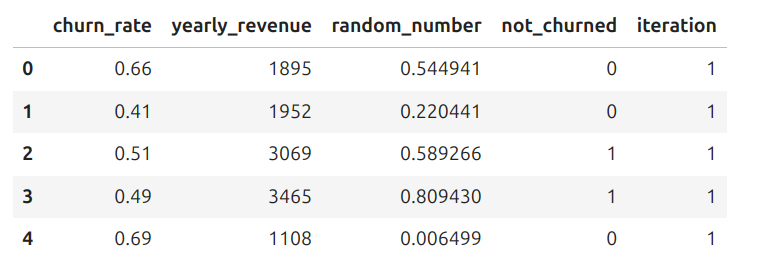
We can summarize our results using the following code:
# Group by 'iteration' and calculate the required values
summary = simulations.groupby('iteration').agg(
total_revenue=('yearly_revenue',
lambda x: sum(x * simulations.loc[x.index, 'not_churned'])),
total_churners=('not_churned', lambda x: 10 - sum(x))
).reset_index()
And finally, plotting this with plotly yields:
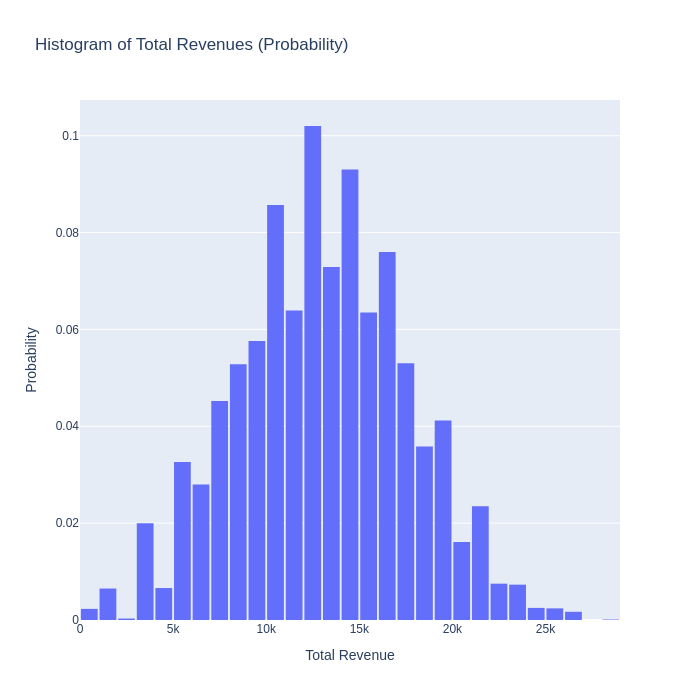
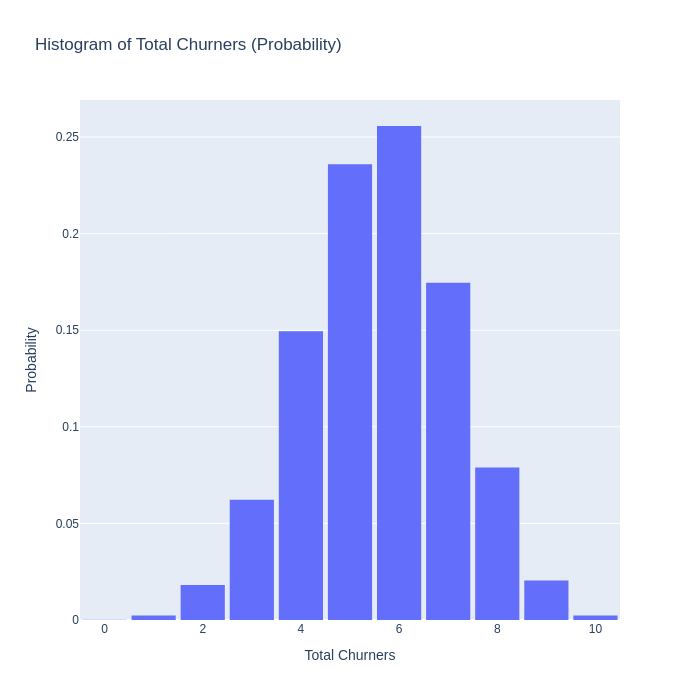
The graphs above tell a much richer story than the two point estimates of 0.56 and 13034 we started with. We now understand much more about the possible outcomes we can expect to see, and we can have an informed discussion about what levels of churn and revenue we we find acceptable.
Continuing with the example above we could for example say that we would only be prepared to accept a 0.1 % chance of 8 or more churn events. Using individual customer price elasticities and simulation based forecasting, we could tweak the expected churn_rates for customers so that we could exactly achieve this outcome. This kind of customer base control is only achievable with an advanced CBM system.
One of the most important factors in pricing is the competitor price. How aggressive competitors are will to a large degree determine how flexible a company can be in its own pricing. This is especially true for commoditized businesses such as utilities or telcos where it’s hard for providers to differentiate. However, despite the importance of competitor pricing, many business choose not to integrate this data into their own price optimization algorithms.
The reasons for not including competitor pricing in price algorithms are varied. Some companies claim that it’s too difficult and time consuming to collect the data, and even if they started now, they still wouldn’t have all the history they need to train all the price elasticity models. Others say the prices of competitor products are not directly comparable to their own and that collecting them would be difficult. Finally, most companies also claim that they have price managers who manually monitor the market and when competitors make moves, they can adjust their own prices in response, so they don’t need to have this data in their algorithms.
The first argument can increasingly be mitigated by good web scraping and other intelligence gathering methods. If that is not enough, there are also sometimes agencies that can provide historic market data on prices for various industries and sectors. Regarding the second argument about not having comparable products, one can also use machine learning techniques to tease out the actual cost of individual product components. Another method is also to use different user personas that can be used to estimate the total monthly costs of a specific set of products or product.
Ultimately, not including competitor prices leaves the pricing algorithms and optimization engines at a disadvantage. In industries where price calculators and comparison websites make it increasingly easy for customers to get a grasp of the market, companies run a risk of being out-competed on price by more advanced competitors.
In this article we have discussed the main components of a customer base management system as well as some of the advanced features that contribute to making these systems invaluable. Personally, having built a few of these systems, I think the combination of price optimization algorithms — running on a broad dataset of internal and external data — coupled with a powerful visual interface in the form a dashboard is one of the most effective tools for managing customers. This combination of tools allows managers and executive leadership really take control of the customer management process and understand the strategic consequence of their actions.
As Jeff Bezos — one of the most customer-obsessed leaders — put it:
“We can assure you that we’ll continue to obsess over customers. We have strong conviction that that approach — in the long term — is every bit as good for owners as it is for customers.” — Jeff Bezos, Amazon 2009 Letter to Shareholders
A commitment to customer management, underpinned by data and AI-driven insights, not only enhances customer satisfaction but also secures long-term value for stakeholders.
Thanks for reading!
Want to be notified whenever I publish a new article? ➡️ Subscribe to my newsletter here ⬅️. It’s free & you can unsubscribe at any time!
If you enjoyed reading this article and would like to access more content from me please feel free to connect with me on LinkedIn at https://www.linkedin.com/in/hans-christian-ekne-1760a259/ or visit my webpage at https://www.ekneconsulting.com/ to explore some of the services I offer. Don’t hesitate to reach out via email at [email protected]
How to Build a Data-Driven Customer Management System was originally published in Towards Data Science on Medium, where people are continuing the conversation by highlighting and responding to this story.
Originally appeared here:
How to Build a Data-Driven Customer Management System
Go Here to Read this Fast! How to Build a Data-Driven Customer Management System